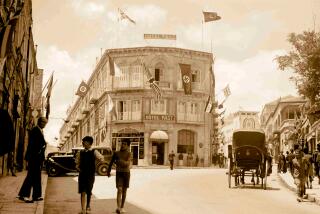Brother, sister in their own world
- Share via
Americans love psychopaths. From the sideways smile of a Jack Nicholson character to classier figures we’d never name as such: Scarlett O’Hara, who used people like tissues; Jay Gatsby, who didn’t see why being a con man should keep him out of high society; and Heathcliff, that violent daydream of every bookish teen girl. We love those glittering, undeniable charismatics, who couldn’t give a damn about us. Conscience is a barrier to glory. Psychopaths are our superheroes.
“Josie and Jack,” Kelly Braffet’s first novel, is a wonderfully sick and twisted book. Jack and Josie are raised by their abusive father, whom they call by their last name, Raeburn. He home-schools them in ancient Greek and calculus, and the brother and sister feel real only to each other. Raeburn believes other people are “diseased cells.” “Drink to yourselves,” he tells them. “The two of you -- you insane ... children -- you’re the world’s only hope.”
“Josie and Jack” is a grim Victorian fairy tale set in the now. The siblings inhabit that Heathcliff and Cathy zone. Left to their devices, they do as they please.
Josie is so beautiful that townspeople just stare. Jack is savagely handsome, smart, funny, almost his own species. At night they share a bed -- chastely -- while Jack shakes in nightmare, giving off waves of anger and fear. “I wanted my coffee to have whiskey in it, and I wanted my brother,” Josie says, “ ... nothing else was all that interesting.”
Writers like Bret Easton Ellis or Mick Foley (whose “Tietam Brown” was gorgeous) focus on the psychopath’s sparkling, hypnotic shine -- on how they look to normal people. But Braffet gets something right that Ellis and others don’t. The psychopath’s world is colorless inside. “Josie and Jack” allows this grayness to come forth; it doesn’t take the easy path of romanticizing the insane.
Jack runs off, and Josie begins to die inside. He was all she knew of the world. Jack returns to find her a wraith and sets out to acquire a beautiful place for her. They head off -- two sibling angels of random destruction who find normal people as alien as ants -- and end up living with Jack’s girlfriend, Becka, in the condensed tackiness of Erie, Pa.
Quotidian concerns annoy a lot of people, but it’s insidious how the normal harms a psychopath’s mind. Josie and Jack lack that wall between thee and me; they have that stalwart glory of small children who feel as though they are the person they love.
But like the very young, people without this wall don’t understand about not harming others. When Becka and her friend Michael interact with Josie and Jack, it’s like mayflies annoying two immortals who don’t understand that other beings feel pain.
Josie and Jack flee to New York. Lily Carter takes them in, charmed when the two rob a coffee shop. Lily lives in a white-on-white Upper West Side apartment, drinks only Cosmopolitans and works for a fashion magazine -- Daddy’s on the board. Jack’s past turns her on, “locked up in that crazy old house all by yourself ... so ‘Flowers in the Attic.’ ” Lily is so chic and pleasant she distracts people from the underlying cruelty of her set. And she thinks she can handle Jack. As one hanger-on remarks, “That’s what Lilys do. They handle things.”
It’s interesting to watch the deliberately acquired pyschopathology of New York’s tragically hip try to measure up to the real thing -- almost, but no cigar. Ironic contempt is just a slightly crude form of innocence at the end of the day, even when that day ends at 4 in the morning in a swank club.
The real quest of the story is whether the calmer, saner-looking Josie is truly like her shining, insane brother. And the answer’s worth finding out.
Modern novels require that ballast that regards extremes of insanity and affluence as equally suspect. Braffet’s book depends on this viewpoint of “normal” middle-class values. And these values still deliver -- seamlessly. “Josie and Jack” is not only wicked fun, but proof that the novel is alive, kicking and can take a reader on a gothic tour of hell, American-style.
More to Read
Sign up for our Book Club newsletter
Get the latest news, events and more from the Los Angeles Times Book Club, and help us get L.A. reading and talking.
You may occasionally receive promotional content from the Los Angeles Times.








